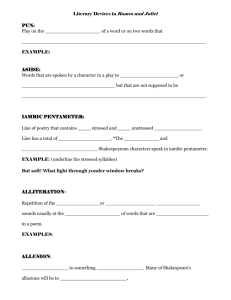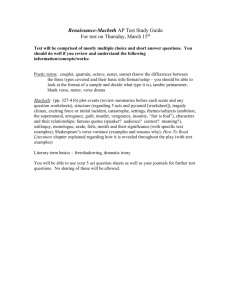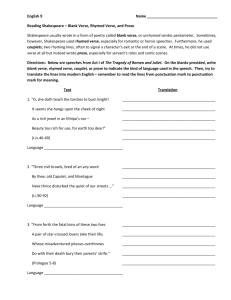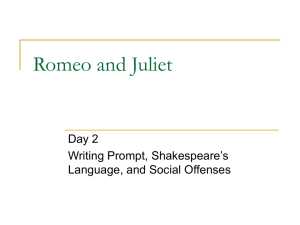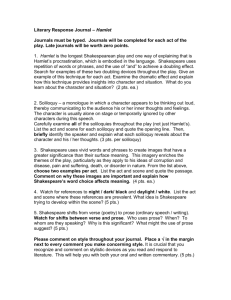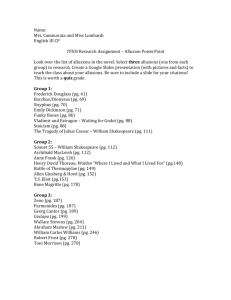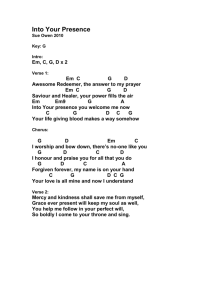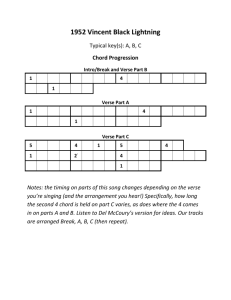Introduction to Shakespeare Gr 9
advertisement
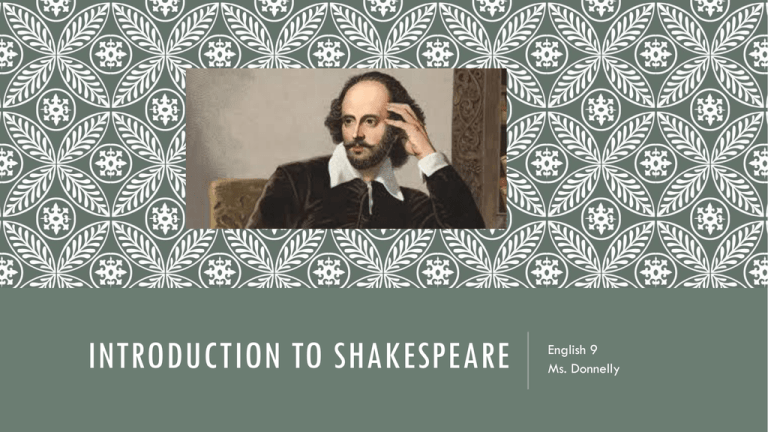
INTRODUCTION TO SHAKESPEARE English 9 Ms. Donnelly SHAKESPEARIAN LANGUAGE Shakespearian language can often be difficult to comprehend because of: • • • • • • • • • Archaic language/obsolete vocabulary terms Allusions Metaphors Wordplay Sentence structure Plotlines Stage Directions Gender roles Switching between verse and prose ARCHAIC AND OBSOLETE WORDS THEE THOU you THY THINE you BETWIXT yours yours between Most of these words are easily recognizable, however, the marginal notes in the book can help you identify unfamiliar terms. ALLUSIONS • Allusions are references to an event, person, place, or artistic work not directly explained or discussed by the author. • Shakespeare was writing for his audience at the time, so he assumes the reader is familiar with his reference. • If you are unfamiliar with an allusion, you can easily Google the term. Example Romeo: Well, in that hit you miss: she’ll not be hit with Cupid’s arrow, she hath Dian’s wit; and in strong proof of chastity well armed (Romeo and Juliet, Act I, Scene 1.) METAPHORS Shakespeare commonly uses metaphors to make comparisons to two dissimilar objects. Example: Duncan: I have begun to plant thee, and will labour To make thee full of growing. (Macbeth, Act I, Scene 1). The king is comparing Macbeth to a tree that he can plant and watch grow. WORDPLAY A pun is a literary device that is used for humor or emphasis with ambiguous words. A pun is used when one word has two distinct meaning. Example- Mercutio: Tomorrow you shall fine me a grave man. A double entendre is a kind of pun in which a word or phrase has a second, usually dirty meaning. A malapropism is when a character mistakenly uses a word that he/she has confused with another word. SENTENCE STRUCTURE • When reading a verse, do not pause at the end of a line. Read from one punctuation mark to the next punctuation mark to get the correct meaning. • An inverted sentence is when the verb comes before the subject. Sometimes it can be easier to read a line if you re-word it and put the subject first. Example: “Never was seen so black a day as this.” (Romeo and Juliet, Act IV, Scene v.) • An ellipsis is when a word of or phrase is left out. Try to fill in the gaps to make sense of the sentence. Example: “I neither know it nor can learn of him. STAGE DIRECTIONS • Shakespeare imagined his plays to be SEEN not to be READ. • Stage directions do not need to be read out loud, but assist the reader in understanding the narration. PROSE AND VERSE Although the plays are dominated by verse, prose plays a significant role. Shakespeare’s prose has its own rhythms, but it lacks the formal patterning of verse, whereas verse typically follows a ten-syllable pattern. In earlier works of Shakespeare, upper-class characters typically spoke in verse, while lower-class characters spoke in prose. The change in speech was used as an indicator of a character’s role in society. MONOLOGUES VS SOLILOQUIES Soliloquies and monologues have one thing in common: they each involve a solitary speaker. The difference between the two doesn't have to do with who's talking but with who's listening. MONOLOGUES A monologue is a speech given by a single person to the other characters within the play. It involves a single character talking for an extended period of time. SOLILOQUY A soliloquy is a speech that one gives to oneself. In a play, a character delivering a soliloquy talks to herself — thinking out loud, as it were — so that the audience better understands what is happening to the character internally.
